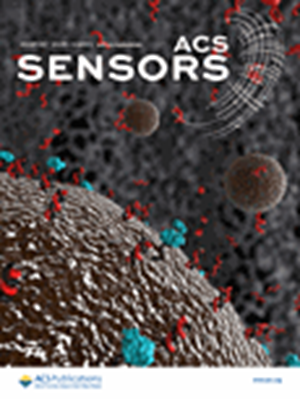纳米工程PDMS/Pd/ zno传感器改善室温下油中H2溶解气体的检测
IF 9.1
1区 化学
Q1 CHEMISTRY, ANALYTICAL
引用次数: 0
摘要
目前的研究目标是合成钯纳米粒子修饰的氧化锌,并开发一种对油中溶解的氢气具有高灵敏度的稳定传感器。采用水热法将ZnO纳米棒(NR)直接合成到带有金数字间电极的商用传感器板上,然后通过滴铸法制备Pd纳米棒(NP)。SEM图像显示ZnO NPs的平均直径为~ 220 nm, Pd球形NPs的直径为35 ~ 75 nm。最后,根据Ostwald系数,通过将传感器浸入封闭系统中的绝缘矿物油中,将不同浓度的H2(从0到500 ppm)注入顶空,然后溶解在矿物油中,来检测传感器的传感性能。所有测量均在室温下进行。电学表征表明,我们的传感器具有良好的重复性,稳定性和灵敏度,可检测较低浓度(小于10 ppm)。此外,通过自旋涂层和热处理,在传感器板上制备了纳米工程多孔PDMS层,然后我们的传感器板的灵敏度达到了~ 2.8 ppm的H2气体。我们的研究结果表明,所应用的方法提高了工业应用中的气体检测性能及其在实时监测中的潜在用途。本文章由计算机程序翻译,如有差异,请以英文原文为准。

Nanoengineered PDMS/Pd/ZnO-Based Sensor to Improve Detection of H2 Dissolved Gas in Oil at Room Temperature
The current research aims to synthesize zinc oxide decorated with palladium nanoparticles and develop a stable sensor with high sensitivity to hydrogen gas dissolved in oil. ZnO nanorods (NR) were synthesized by a hydrothermal method directly onto a commercial sensor board with gold interdigital electrodes, followed by functionalization with Pd nanoparticles (NP) by drop casting. SEM images show ZnO NRs with an average diameter of ∼220 nm and Pd spherical NPs with diameters of 35–75 nm. Finally, the sensing properties were examined by immersing the sensor into insulating mineral oil in a closed system, where different H2 concentrations (from 0 up to 500 ppm) were injected into the headspace and then dissolved in the mineral oil, according to the Ostwald coefficient. All measurements were carried out at room temperature. The electrical characterization showed that our sensor had good repeatability, stability, and sensitivity to detect lower concentrations (less than 10 ppm). Additionally, a nanoengineered porous layer of PDMS was prepared over the sensor board through spin coating and heat treatment, and then the sensitivity of our sensor board reached ∼2.8 ppm of H2 gas. Our findings indicate that the methodology applied improves gas detection performance in industrial applications and its potential use for real-time monitoring.
求助全文
通过发布文献求助,成功后即可免费获取论文全文。
去求助
来源期刊

ACS Sensors
Chemical Engineering-Bioengineering
CiteScore
14.50
自引率
3.40%
发文量
372
期刊介绍:
ACS Sensors is a peer-reviewed research journal that focuses on the dissemination of new and original knowledge in the field of sensor science, particularly those that selectively sense chemical or biological species or processes. The journal covers a broad range of topics, including but not limited to biosensors, chemical sensors, gas sensors, intracellular sensors, single molecule sensors, cell chips, and microfluidic devices. It aims to publish articles that address conceptual advances in sensing technology applicable to various types of analytes or application papers that report on the use of existing sensing concepts in new ways or for new analytes.
 求助内容:
求助内容: 应助结果提醒方式:
应助结果提醒方式:


